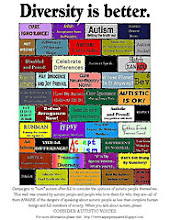Social compass:- how we fail our children
Sometimes my head hurts as I try to keep ahead of the wide variety of scenarios in every day situations. I believe that this is why autism is exhausting, not physically, but the mental gymnastics of holding together a wide collection of possibilities, weighing, comparing and analyzing the likelihood of any particular outcome.
One of the reasons that some parents are extremely inefficient is because they fail to adopt an adequate decision making matrix. To paraphrase "Quality Tools":-
A decision matrix evaluates and prioritizes a list of options. The team first establishes a list of weighted criteria and then evaluates each option against those criteria. This is a variation of the L-shaped matrix.
This is a simple approach for parents to absorb, strategically and systematically. Once this "system" is in place apply logic:-
The a list of options must be narrowed to one choice.
The decision must be made on the basis of several criteria.
The list of options has been reduced to a manageable number by list reduction.
Just like that we regain control so as to more forward on a consistent platform. If only more parents would follow this logical path, then all sorts of social situations would become a breeze:-
We wait for my daughter to return from school after a field trip that runs late. My older son climbs the play structure with all the other waiting siblings. Mother’s huddle in groups chatting. I sit on the bench with my youngest son curled up horizontally in my lap, as he endures the torture of ‘wait.’
One of the siblings comes in the form of a small four year old or large three year old. He play punches my son as he climbs. It’s good humoured on both parts. My son gets the chance to play the cool, tolerant older kid. I concentrate on the child that meows, furled tightly on my thighs. I stroke and massage his shoulders to keep him calmer, if not really calm.
A mother approaches Mr. Punch as his enthusiasm grows, “hey, stop beatin up the big kids,” she calls playfully, because we all see the joke, huge nine year old and a little enthusiastic tot.
The children disperse into different groups and activities. The small boy follows my son, or possibly the other way around, as he always gravitates to little kids, given the opportunity. I watch as the play punches get harder and more frequent.
I wave an arm and call his name, but he blows me off, “it’s o.k. mom, I like it.” I know that he does, the attention, the physical contact and anyway, it’s fun. What would a typical nearly 10 year old do in this situation? I have no idea.
I dither as I watch at wait. He seems to be holding his own. Another little boy joins them. They both throw punches, encouraged by my son:- ‘bring it on.’ He laughs and jokes with them. Two against one isn’t fair, but it’s not two against one, it’s two eights against one, and they’re not really against. He play acts pain, an exaggerated cariacature with a huge grin on his face, which encourages more blows, if you can call them blows, which you probably can’t. The weight on my lap shifts as he turns his attention to his brother, “he is play wiv his friends?”
“Hmm, yes he is.”
“I play too!” he announces as he zips off to join the other three, stiff legged and armed, Mario style. I remain on the bench uncertain. I look at my two large boys who almost match each other in height after a brief growing spurt. They currently enjoy the number of enquiries, “are you guys twins?” the attention, the joke, the trick, no matter how often, as repeats are welcome.
The little boys’ focus remains on him, as my younger son stands on the periphery, the sidelines outside of an invisible field of shared attention, a exclusive boundary.
Now my focus changes. Not on my son, who is happy to bask in their attention, but to the possibilies from my other son. He has been known to defend his brother from what he perceives as attacks. Commendable mis-fires. There is the chance that he will join in and either punch his brother, or worse still, punch one of the little boys. It’s just the kind of thing that we hear about in the media:- ‘autistic child caught in unprovoked and mindless attack on innocent toddler.’ There’s never a back story. Sometimes the back story comes later, but it’s the headline that sticks in the mind of the public. It’s not dislodged, erased or superceded. As a result the public is left with a random collection of negative assumptions to apply to the autistic population, a general shorthand. Each additional headline loads another brick in the wall of segregation, isolation and mis-information.
My son would be copying and joining in. He would be adopting the apparent cultural norms. He would be unlikely to hit them hard but he is double their age and size. Alternatively, one of the little boys might hit him. If this should happen, he who cannot be touched by anyone, would be likely to scream the place down, which would be fine if a little disconcerting for some, but he might hit back, which would not be fine.
If I step in I am both a kill joy and over-protective. If I remain un-engaged I risk serious fall-out. If I step in, I need to decide how? If I don’t hurry up the decision may be taken away from me. I glance at the mums who chat with an eye on the road for the awaited bus. Until I saw her look, I had completely forgotten about the bus. And look, there is the bus! I blink back at my son who is on the ground doubled up. No sign of the tots as they scamper off to the bus. His brother crouches by his shoulder with his arms over his head, as he rocks in commiseration. “It was an accident!” he yells, “that lil guy didn’t mean it.”
I’m sure he’s right but my decision making matrix is wrong.



































